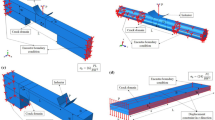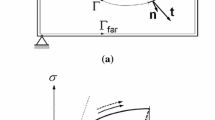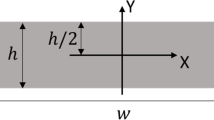Abstract
The effects of specimen type (precracked tension or bend) on the relationship between the J-integral and the crack tip opening displacement (COD) and on crack initiation values of J and COD were investigated. The material used was a mild steel. COD was measured by infiltrating the crack with a catalytically hardening silicone rubber. The J-integral was measured both by the compliance technique and using analytical formulae. No significant effect of specimen type was noted. Measurements of J from the analytical formulae used agreed well with compliance measurements. Simultaneous J and COD values were also measured on a low alloy steel. The results indicate that the J/G/COD relationships are material dependent, possibly being controlled by the material's work-hardening rate.
Résumé
On a étudié, sur un acier doux, les effets du type d'éprouvette—préfissurée pour essai de traction ou de flexion—sur la relation entre l'intégrale J et le COD, ainsi que sur les valeurs critiques à l'amorçage de J et de COD. On a mesuré le COD en injectant dans la fissure un caoutchouc de silicone à durcissement catalytique. L'intégrale J a été mesurée, de son côté, à la fois par une technique de compliance et par des formules analytiques. On n'a pas noté une influence significative du type d'éprouvette. Les mesures de J émanant des formules analytiques sont en bon accord avec les mesures par compliance. Des mesures simultanées de J et du COD ont également été effectuées sur un acier faiblement allié. Les résultats montrent que les relations entre J, G et le COD dépendent du matériau et qu'elles sont probablement régies per leur module d'écrouissage.
Similar content being viewed by others
References
A. A. Wells, in Proceedings of the Crack Propagation Symposium, The College of Aeronautics, Cranfield, England, 1 (1961) 210–230.
F. J. Witt in Conference on Practical Application of Fracture Mechanics to Pressure-Vessel Technology, The Institution of Mechanical Engineers, London (1971) 163–167.
J. A. Begley and J. D. Landes in Fracture Toughness, Proceedings of the 1971 National Symposium on Fracture Mechanics, Part II, ASTM STP 514, American Society for Testing and Materials (1972) 1–20.
H. Liebowitz and J. Eftis, Nuclear Engineering and Design, 18 (1972) 457–467.
J. D. Landes and J. A. Begley in Fracture Analysis, ASTM STP 560, American Society for Testing and Materials (1974) 170–186.
D. J. Hayes and C. E. Turner, International Journal of Fracture, 10 (1974) 17–32.
E. F. Boyle, The Calculation of Elastic and Plastic Crack Extension Forces, Ph.D. Dissertation, Faculty of Applied Science and Technology, Queen's University, Belfast, N. Ireland (1972).
J. G. Sumpter, D. J. Hayes, G. T. Jones and C. E. Turner, Post Yield Analysis and Fracture in Notch Tension Pieces, presented at the Third International Conference on Fracture, Munich, Germany, April 1973.
J. D. G. Sumpter, Elastic-Plastic Fracture Analysis and Design using the Finite Element Method, Ph.D. Dissertation, Faculty of Engineering, University of London (1973).
F. M. Burdekin and D. E. W. Stone, Journal of Strain Analysis, 1 (1966) 145–153.
N. Levy, P. V. Marcal, W. J. Ostergren and J. R. Rice, International Journal of Fracture Mechanics, 7 (1971) 143–156.
J. N. Robinson and A. S. Tetelman in Fracture Toughness and Slow-Stable Cracking, ASTM STP 559, American Society for Testing and Materials (1974) 139–158.
Methods for Crack Opening Displacement (COD) Testing, Draft for Development, DD19: 1972, British Standards Institution, London (1972).
J. N. Robinson and A. S. Tetelman, Comparison of Various Methods of Measuring K 1c on Small Precracked Bend Specimens that Fracture after General Yield, Engineering Fracture Mechanics, in press.
J. R. Rice, P. C. Paris and J. G. Merkle in Progress in Flaw Growth and Fracture Toughness Testing, ASTM STP 536, American Society for Testing and Materials (1973) 231–245.
J. D. G. Sumpter and C. E. Turner, A Method for Laboratory Determination of J c, presented at the Ninth National Symposium on Fracture Mechanics, University of Pittsburgh, August 1975.
J. N. Robinson and A. S. Tetelman, International Journal of Fracture, 11 (1975) 453–468.
D. Broek, Correlation between Fracture Toughness and Stretched Zone Size, presented at the Third International Conference on Fracture, Munich, Germany, April 1973.
K. Erhardt, A Quantitative Fractographic Approach to Brittle Fracture, Material und Technik, 7 (1974) 10–13.
I. D. Lewis, R. F. Smith and J. F. Knott, International Journal of Fracture, Reports of Current Research, 11 (1975) 179–183.
A. S. Tetelman, J. N. Robinson and I. Roman, in Prospects of Fracture Mechanics, Noordhoff International Publishing, Leyden, Holland (1974) 563–578.
J. N. Kass, J. A. Begley and H. Andrejasik, Journal of Testing and Evaluation, 2 (1974) 304–316.
Author information
Authors and Affiliations
Rights and permissions
About this article
Cite this article
Robinson, J.N. An experimental investigation of the effect of specimen type on the crack tip opening displacement and J-integral fracture criteria. Int J Fract 12, 723–737 (1976). https://doi.org/10.1007/BF00037918
Received:
Revised:
Issue Date:
DOI: https://doi.org/10.1007/BF00037918




